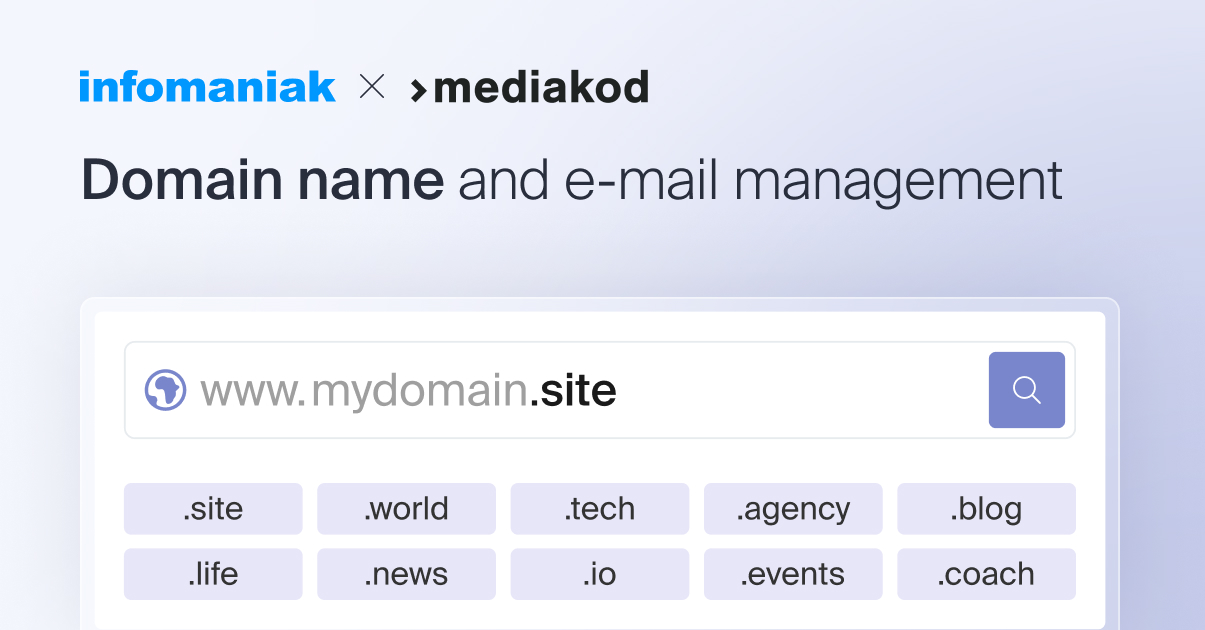Clients generally prefer brands that have proven themselves and are often reluctant to try something new… Unless they have a good reason to.
This being the case, the most powerful tool at your disposal is effective content marketing. It’s a matter of catering to your prospects’ needs – not via ordinary adverts, but through engaging, inspiring content that really addresses their problems. The simplest way to get that content out there is in a blog.
Companies who use a blog are 13 times more likely to improve their return on investment. In addition, 53% of marketing specialists confirm that blogging is the main element in their content marketing strategy. OptinMonster
The success of a blog, however, isn’t just down to the creation of useful content, it also has to be promoted effectively.
1. Find the perfect domain name for your blog
The potential of a good domain name is often underestimated, which is why there are hundreds of blogs with domain names like company.com/blog/ or xyz.company.com.
Your blog will generate relevant traffic, so it’s important that it has its own identity that’s unique and memorable to boot. A great way of achieving this is to have a dedicated, specific domain name for your blog.
The perfect domain for your blog should be:
- unique and memorable
- related to your content
- linked to your company or your brand
- short and simple, with no special characters, numbers or altered spellings
New extensions offer plenty of opportunities to register contextual, creative domains. For a tech journalist called Jonas, a domain like www.jonastalks.tech, for example, could be a great option.
Going even further:
- Register a domain name for your blog
- Our advice for choosing a good domain name
- How to avoid losing an important domain name
2. Sponsor your content on social media
Facebook is one of the easiest and most cost-effective platforms for promoting content. Aside from the low cost of cost per click, Facebook has integrated mechanisms that are very effective at targeting your ideal prospects.
However, it’s important to note that your posts won’t reach a wide audience on their own, even if your page has thousands of fans. The platform’s algorithm, when operating organically, only shows your posts to a very small percentage of people.
To expand your audience and attract fans, unfortunately you have to advertise or boost your posts:
- Create a convincing message that looks good and includes a link to your content.
- Sponsor the post for a short time. Start with a small budget to evaluate performance.
- Depending on the results and your goals (scope, traffic, conversion, return on investment, etc.), continue promoting your blog or test out other ideas.
To understand how your audience is reacting to your content, analyse your results according to a number of criteria, such as content (text/image/video), the advertising format, audiences and the time it takes to place the adverts. It’s a good idea to have more than one advert running at a time and evaluate how they perform using A/B tests in the Facebook Ads Manager. Your aim is to understand which ad works best with your audience in relation to your goals so you don’t waste money.
3. Optimise your content for search engines
Search engines rank your blog posts according to three main criteria:
A. The relevance of your content in relation to the search terms
B. The quality of backlinks that link to your content
C. Page design and loading speed
A. Offer solutions to your audience’s main problems
An important aspect of SEO is targeting popular keywords that people are searching and using them in your content. Overusing keywords, though, can lower the quality of your content, meaning search engines may classify it as spam.
For example, if you’re a fitness expert preparing an article on exercises to do at home to stay in shape during lockdown, you could see which search terms are popular in that category (e.g. “home workouts”). Ideally, you’d want to use this key term in your title, the URL, your metatext and in the first 100 words of the article.
To learn more, check out our SEO guide.
B. Create quotable content to get backlinked
Search engines treat backlinks like votes of confidence. When relevant sites talk about your content, your blog benefits from their reputation. One of the best ways to improve your backlink portfolio is to share useful data that people will want to quote in their content, such as white papers, graphs, statistics, infographics and case studies on well-known companies.
You can also create internal links to pages on your website and blog to cross-promote your own content. For example, if you publish an article on healthy summer recipes and you already have an article about healthy foods to eat in summer, it makes sense to create an internal link to the previous article as it gives your readers more information to check out.
C. Optimise your blog and choose an effective host
Your content may be interesting and full of keywords but, if it takes too long to load, people will quickly move on to the next result.
Here are some ways you can quickly increase the speed of your blog:
- Choose an effective host that regularly upgrades its infrastructures.
- Regularly update your CMS, theme and the extensions you use.
- Delete unnecessary or poorly optimised extensions.
- Host your videos on a video on demand service.
- Optimise your images.
Going even further:
- Speed up access to your blog in one click (without changing your site)
- How to measure a website’s loading speed
- Optimise a website’s loading time
- Six ways to optimise a WordPress website
4. Take advantage of Twitter and LinkedIn
Twitter is a platform that makes it easy to reach people with the same interests as you. In addition to posting your own content, you can also retweet messages from other brands and people you follow. To increase the number of people your tweets reach organically, use services like ritetag.com to find relevant hashtags.
LinkedIn is a professional platform where the content related to trends in your industry, success stories, case studies and skills development is generally high-quality. Also think about joining relevant LinkedIn groups where you can share your content or comment on messages posted by other members to grow your brand’s reputation.
5. Use forums and sites like Quora and Reddit
By answering questions related to your skill set and expertise, you can establish yourself as an opinion leader while also promoting your blog and your company. People are always looking for information on platforms like Quora and Reddit.
***
Once targeted traffic accesses your blog, the next step is to invite visitors to sign up for your newsletter in exchange for private content that can help them achieve results. This can automatically generate and qualify future prospects for your company. E-mail marketing is one of the most effective ways of converting your visitors into prospects and your prospects into clients by establishing a lasting relationship with your audience.
Going even further:
- Discover Infomaniak’s newsletter tool
- Measure the effectiveness of your subscription pages
- Five reasons to include a newsletter on your site immediately
***
This article was submitted by Alisha, Senior Content Marketing & Communication Specialist at Radix, the registry behind new, extremely popular domain extensions such as .STORE et .TECH. You can follow her on LinkedIn and Twitter.
SwissTransfer: how ecodesign has made it possible to save 400 W on a continuous basis
Tuesday May 13th, 2025

 Français
Français Deutsch
Deutsch Italiano
Italiano Español
Español




